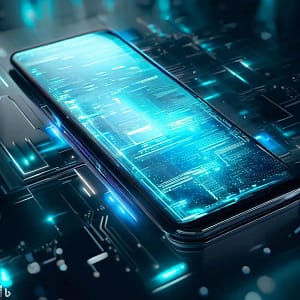Introduction
Smartphones, which are mobile phones with powerful computer capabilities, have transformed how we connect and access data. These portable gadgets can do a variety of things, including making phone calls, sending texts, accessing the web, playing games, capturing images and video, and using social media apps.
Smartphones have become indispensable in our daily lives, allowing us to stay in touch with people all over the world and access information whenever and wherever we choose. They have transformed how we work, study, and connect socially, and have become an essential resource for personal and professional communication.
What is Next?
So, did we reach to a dead-end with smart phone features?
Are there any new features we still need moving forward?
Smartphones are becoming increasingly sophisticated with the advancement of technology, providing advanced functionalities such as facial recognition, augmented reality, artificial intelligence, and many others.
Below are some important new venues smart phones need to have and enhance in future in order to compete in the ever-evolving market;
5G Adoption
5G is the latest generation of mobile network technology that offers faster data speeds, lower latency, and improved reliability compared to previous generations. When it comes to smartphones, 5G allows for faster download and upload speeds, smoother streaming of high-quality video and audio, and faster web browsing. With 5G, smartphone users can experience a more seamless and responsive online experience, with faster loading times and reduced buffering.
In addition to its speed benefits, 5G is expected to enable new applications and technologies, which require high-bandwidth and low-latency networks. Many smartphone manufacturers are already releasing 5G-enabled devices, and as the technology continues to roll out across the world, it is expected to become the new standard for mobile networks.
Mobile Payments
Mobile payments have become an essential part of modern payment systems, with the rising popularity of mobile devices and their usage for daily activities such as socializing, banking, and shopping. As the trend continues, we can anticipate more innovative payment technologies and services that offer greater convenience, security, and personalization.
The use of biometrics for authentication, integration of mobile wallets with loyalty programs and rewards, and adoption of cryptocurrencies and blockchain technology are some emerging trends in mobile payments. Additionally, mobile payments are expected to play a significant role in promoting financial inclusion and supporting the expansion of the global digital economy.

Mobile Commerce
The landscape of mobile commerce, also known as m-commerce, is continuously changing as more and more consumers turn to their mobile devices for shopping and purchasing goods and services. The convenience and ease of access provided by mobile devices have been the primary catalysts behind the rapid growth of m-commerce in recent times.
In the future, we can expect to see even more creative and tailor-made m-commerce experiences designed to meet the unique demands and desires of each customer. These experiences may include the use of advanced technologies such as augmented reality, artificial intelligence, and voice assistants to enhance the shopping experience and provide customized recommendations.
Mobile Virtual Reality
Mobile Virtual Reality (MVR) is an innovative technology that enables immersive experiences using a portable, lightweight device, with seemingly endless possibilities for its use cases. One of the most prominent applications of MVR is in the gaming industry, where it can offer players highly realistic and immersive environments. Apart from gaming,
MVR has significant potential in education, where it can provide students with interactive and captivating learning experiences like virtual field trips or scientific experiments. MVR can also be applied in various other fields, such as healthcare, entertainment, architecture, and real estate. As the development of MVR technology continues, and the demand for immersive experiences increases, we can anticipate even more exciting and diverse use cases in the future.
Mobile Augmented Reality (AR)
Mobile augmented reality (AR) technology superimposes digital content or objects onto the real world using a mobile device’s camera. It has enormous potential for applications ranging from entertainment and gaming to education, retail, and healthcare. By bridging the physical and virtual worlds, it enables immersive and interactive experiences for users.
For example, in retail, customers can use Mobile AR to try on clothes or visualize how furniture would look in their homes prior to purchasing. In education, it enables engaging and interactive lessons, such as virtual science experiments or historical reenactments. In healthcare, Mobile AR can simulate surgeries and provide medical training, while in gaming, it creates realistic and immersive environments for players.
Overall, Mobile AR has the potential to transform how we use smartphones and interact with the world, leading to new opportunities for innovation and creativity across industries. By overlaying digital objects on the real world, it offers a seamless blend of virtual and physical reality that is reimagining user experiences in profound and compelling ways. Mobile AR promises to revolutionize numerous sectors by bringing computing power, rich media, and interactivity out of the digital realm and into the everyday spaces around us.
Internet of Things (IoT)
Internet of Things is the interconnection of various devices and objects that can communicate with each other and exchange data through the internet. As more and more devices become IoT-enabled, including home appliances, cars, and wearables, smart phones are going to play a crucial role in managing and interacting with these devices in the future.
One of the major ways that IoT will affect smart phones is through the rise of smart homes. In the near future, smart homes will be fully automated and controlled by a central hub, which will be accessible through a smartphone app. Users will be able to control their lights, temperature, security systems, and other devices with a single tap on their smartphone. Smart phones will also be able to provide real-time data about energy consumption and suggest ways to reduce energy usage.
Another impact of IoT on smart phones is in the field of healthcare. Wearable devices such as fitness trackers, blood pressure monitors, and glucose meters can be connected to a smartphone to monitor health data in real-time. This data can be shared with healthcare professionals, who can provide personalized recommendations and treatment plans.
IoT also presents new opportunities for businesses to improve their operations and enhance customer experience. For example, smart retailers can use IoT-enabled devices to track inventory levels, monitor customer behavior, and create personalized shopping experiences. Smart phones will be the primary interface through which customers interact with these devices and access these services.
In summary, IoT is going to have a significant impact on smart phones in the future, as they will become the central hub for managing and interacting with IoT-enabled devices in various industries.
Artificial Intelligence (AI) and Machine Learning (ML)
AI and Machine Learning are rapidly evolving technologies that will have a profound impact on the future of smartphones. Below are some of the ways in which they are expected to influence smartphones:
- Personalization: AI and ML will enable smart phones to become more personalized to their users. By analyzing user data and behavior patterns, smart phones will be able to suggest personalized content, such as apps, music, and news articles.
- Voice assistants: With the development of AI and ML, voice assistants like Siri, Alexa, and Google Assistant have become increasingly sophisticated. These assistants will continue to evolve, becoming more intuitive and capable of understanding natural language, which will enhance their functionality.
- Image recognition: Smart phones will use AI and ML to improve their image recognition capabilities, making it easier to identify and categorize images. This will enable users to easily search for and find images on their smart phones.
- Security: AI and ML will play a critical role in improving smart phone security. These technologies will enable devices to learn a user’s behavior patterns and identify abnormal behavior, which will help to detect and prevent cyber attacks.
- Battery life: By analyzing user behaviour patterns, smartphones will be able to optimize app usage to conserve battery and reduce the need for frequent charging.
Conclusion
In summary, smartphones have become essential in our daily activities, allowing us to stay connected, updated, and entertained. Fast technological progress has enabled smartphones to constantly evolve and adapt to new innovations like 5G, the Internet of Things, artificial intelligence, and machine learning—with more on the way. As these technologies continue advancing, we can expect smartphones to become even more powerful and able to meet the demands of today’s fast-paced life. For work or play, communication or information, smartphones have become indispensable tools that help us stay connected and succeed in our high-speed world.



